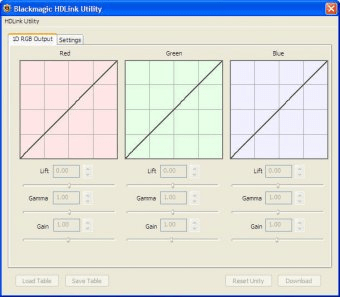
- Blackmagic Hdlink Utility Mac
Connect your HDLink Pro 3D DisplayPort momentarily via USB to your computer and apply power to it. Run the HDLink 3.5.2 (or later) software. If it offers to update the firmware, following the instructions on screen. Choose Preferences from the HDLink Utility menu and then Override EDID. What Blackmagic. HDLink Utility enables you to update your HDLink with the latest firmware. Firmware updates may add new features, support new formats and standards, or provide increased compatibility with other video and audio hardware. It is always best to use the latest version of HDLink Utility so you receive all the latest updates for your HDLink. Blackmagic URSA Mini Pro 4.6K G2. Get an amazing Super 35mm 4.6K sensor with 15 stops of dynamic range up to 120 fps or 2K at 300 fps! Includes features such as 3 x ND filters, Blackmagic RAW, USB-C external disk recording and more! Blackmagic Color BlackMagic is a photo coloring software for PC Windows. It is used to colorize. $39 DOWNLOAD Blackmagic HDLink HDLink Utility enables you to update your HDLink with the latest firmware. The 4.0.5 version of Blackmagic SmartView Utility is available as a free download on our website. This download was scanned by our antivirus and was rated as malware free. The following versions: 4.0, 3.0 and 2.0 are the most frequently downloaded ones by the program user.


An Elegant Way to Monitor HD Video on an SD Screen
Accurate monitoring during high-definition production is absolutely critical; an SD monitor just can’t show you potential problems with your footage. From bad makeup jobs to product labels that managed to wander into the background, HD shows everything. But what if you don’t have, or can’t afford to rent or buy, an HD monitor? Blackmagic Design has an elegant and relatively inexpensive solution with the HDLink, a small SDI-to-DVI converter box that lets you monitor your HD video using a standard LCD computer monitor.
HDLink couldn’t be easier to set up: simply connect your SDI source to the 4:2:2 or 4:4:4 SDI input, then connect the DVI port to your LCD monitor. You’ll also need to connect the power adaptor, as well as the HDLink, to a USB port on a Mac or PC computer in order to update the firmware. Once you’re connected, you’ll access the slick HDLink utility that lets you set up gamma look-up tables to precisely match luma levels on the screen with specific applications. Very sweet.


To display a 1080i image, you’ll need an LCD display that has a native resolution of 1920 pixels by 1200 pixels, a spec you’ll find in most 23-inch LCD monitors. For this review, I used a 23-inch Apple Cinema Display, which worked beautifully. In production, HDLink worked like a champ, accurately displaying my HDCAM and uncompressed D1 images pixel for pixel. Overall, I found the colors and focus displayed on the Cinema Display to be excellent. There was only one surprising thing that I couldn’t resolve: A visual glitch showed up when I connected the HDLink to my Blackmagic Design DeckLink Pro card. However, the HDLink worked fine on all other SDI sources.
It did strike me as odd that while the HDLink includes the power supply, the user has to supply the main power cord, though any standard grounded AC cable will do.

Blackmagic Hdlink Utility Mac
Renting multiple HD monitors in production and post-production can cost you as much as $500 per day. Yet for around $700, you can use HDLink with one of your existing 23-inch LCD displays to create a cost-effective HD monitoring system. Ultimately, you’ll still want to use a good production monitor and a Waveform/Vectorscope to confidently monitor your HD signal. But being able to repurpose your LCD monitor as an HD display is a good business move. Even if you do just one HD production in a year, the HDLink will quickly pay for itself.






